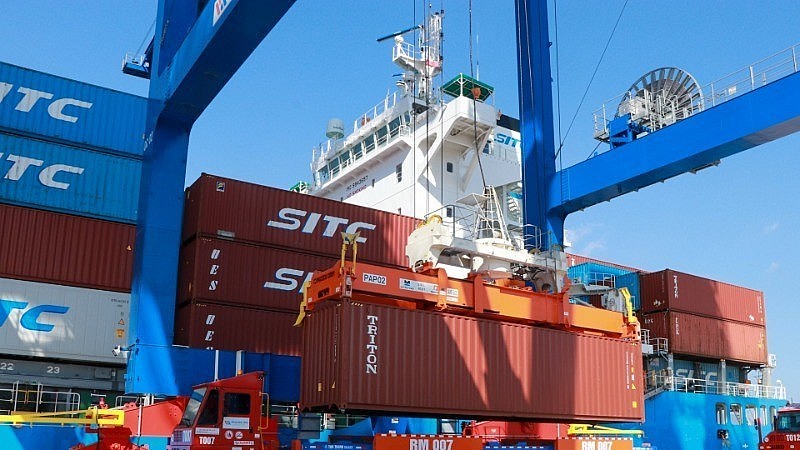 |
| Cargo handling at Phuoc An Port, Nhon Trach District, Dong Nai Province. (Photo: CONG PHONG) |
The Ministry of Industry and Trade is finalising the Viet Nam Logistics Service Development Strategy for the 2025–2035 period, with a vision to 2045. The strategy aims to reduce logistics costs to 12–15% of GDP and achieve annual industry growth rates of 15–20%. At the same time, logistics will be integrated into the national green growth strategy, with targets including 30% of logistics vehicles using clean energy and 80% of logistics firms adopting digital transformation.
Boosting efficiency and reducing costs
Assessing the current state of Viet Nam’s logistics sector, Dr Bui Ba Nghiem, Senior Specialist at the Export-Import Department under the Ministry of Industry and Trade, said that the sector has grown rapidly in recent years and has become an increasingly important service industry for the national economy. However, the logistics sector still faces numerous limitations.
While the domestic logistics market has expanded, it remains largely confined within national borders and does not yet match the country’s potential and advantages. Logistics infrastructure is underdeveloped, fragmented, and lacks connectivity, thereby limiting development and resulting in high logistics costs that reduce the competitiveness of Viet Namese businesses.
Moreover, although the number of logistics service providers has increased, most are small and medium-sized enterprises with limited capital, technology, and international experience. Human resources in the sector are also lacking in both quantity and quality, with few professionally trained in logistics operations.
To develop the logistics sector in the future, Nghiem emphasised the need for breakthroughs in legal and institutional reforms to improve the investment and business environment and encourage participation from all economic sectors. Viet Nam must also accelerate investment in the construction and development of a modern, synchronised logistics infrastructure. Enterprises should strengthen linkages, restructure operations, and focus on applying technology, digital transformation, and green practices in logistics activities, while also enhancing human resources and service quality.
From a business perspective, Pham Nguyen Thanh Quang, Director of LEX Viet Nam (formerly Lazada Logistics), said that “In today’s 4.0 era, logistics has become a high-tech service sector.” LEX Viet Nam has adopted advanced technologies such as Artificial Intelligence (AI), Big Data, the Internet of Things (IoT), and supply chain management systems to automate processes and improve customer experience. AI systems are integrated into all stages, from order forecasting and delivery route optimisation to warehouse coordination and consumer behaviour analysis.
| Thanks to the focus on AI, Big Data, and Machine Learning, new business models such as instant delivery or scheduled delivery have emerged and are being applied effectively. |
Using AI and Big Data, LEX Viet Nam has developed highly accurate real-time order forecasting models that help optimise resource allocation during peak seasons or major promotional campaigns. Its smart warehouse at the automated sorting centre in Binh Duong is now 99% automated using the latest technology, ensuring fast and reliable delivery services for customers.
Thanks to the focus on AI, Big Data, and Machine Learning, new business models such as instant delivery or scheduled delivery have emerged and are being applied effectively. Along with that, digital transformation helps logistics businesses increase the speed of processing and packaging orders in the warehouse, reduce errors, optimise delivery time, thereby improving productivity, reducing costs and optimising operations.
“Viet Namese logistics firms need to invest more in technology and prioritise the development of digital logistics human resources in collaboration with training institutions,” Mr Quang recommended.
Integrating multimodal transport
Emphasising that green transformation is an irreversible global trend and a prerequisite for integration, Cap Trong Cuong, General Director of Macstar Group JSC, stated: “Green logistics is a matter of survival for Viet Namese logistics firms, particularly in transport, seaports, and warehousing. These sectors must proactively undergo green transformation to avoid exclusion from global supply chains.”
However, the challenges for green transformation remain significant. Legal frameworks, standards, regulations, enforcement mechanisms, and incentives for green transition are still unclear. Most Viet Namese enterprises lack the capital to invest in green technologies and vehicles, as well as concrete solutions and qualified personnel, especially environmental technology experts and emissions specialists. Therefore, the government should establish national green logistics criteria and introduce supportive financial policies such as green credit and tax incentives to aid business transition.
Cuong also said that one effective solution to accelerate green logistics is to leverage waterway transport. Viet Nam’s dense river network and long coastline offer significant potential for developing coastal and inland waterway transport. Waterways can help ease pressure on road transport and optimise costs, particularly for containers and bulk cargo. Moreover, Macstar’s research indicates that water transport can cut emissions by up to 70% compared to road transport.
Truong Thi Mui, Deputy General Director of Bac Giang International Logistics Company, pointed out that in Viet Nam, road transport still dominates, accounting for 70–75% of freight transport, which pushes up logistics costs and makes the system vulnerable to fuel price volatility and congestion. In contrast, other modes like rail and inland waterway, which offer great potential, remain underutilised due to disconnected infrastructure, fragmented planning, and outdated technology.
For example, the northern midland region has major advantages for integrating road, rail, and waterway transport in logistics operations, but these modes are still developing in isolation. Integrating multimodal transport with smart warehousing and building tiered supply chains could reduce logistics costs by 10–15% for key sectors such as e-commerce, textiles, and electronics.
Currently, the Bac Giang International Logistics Centre is developing an inter-regional transport corridor based on multimodal transport. The centre has already connected with key expressways such as the Hanoi–Bac Giang–Lang Son route, and is implementing a full-service logistics solution from Nanning (China) to Yen Vien Station (Hanoi), with a transhipment stop at Kep Station (Bac Giang).
Unfortunately, Kep Station’s rail infrastructure has not been capable of supporting a competitive rail transport offering. Meanwhile, the inland ports along the Cau, Thuong, and Luc Nam rivers are being studied for integration into a water–road–rail logistics corridor, opening new pathways for inter-provincial and cross-border supply chains.
Mui urged the government to prioritise investment in inland waterways and railway transport. Businesses themselves are also eager to invest more systematically, with support from relevant authorities, to build modern multimodal logistics systems that bring mutual benefits to the entire sector.
With strong support from the government, ministries, local authorities, and the business community, Viet Nam is fully capable of building a green, intelligent, fully connected logistics system, propelling the nation’s competitiveness in the new era./.





















































